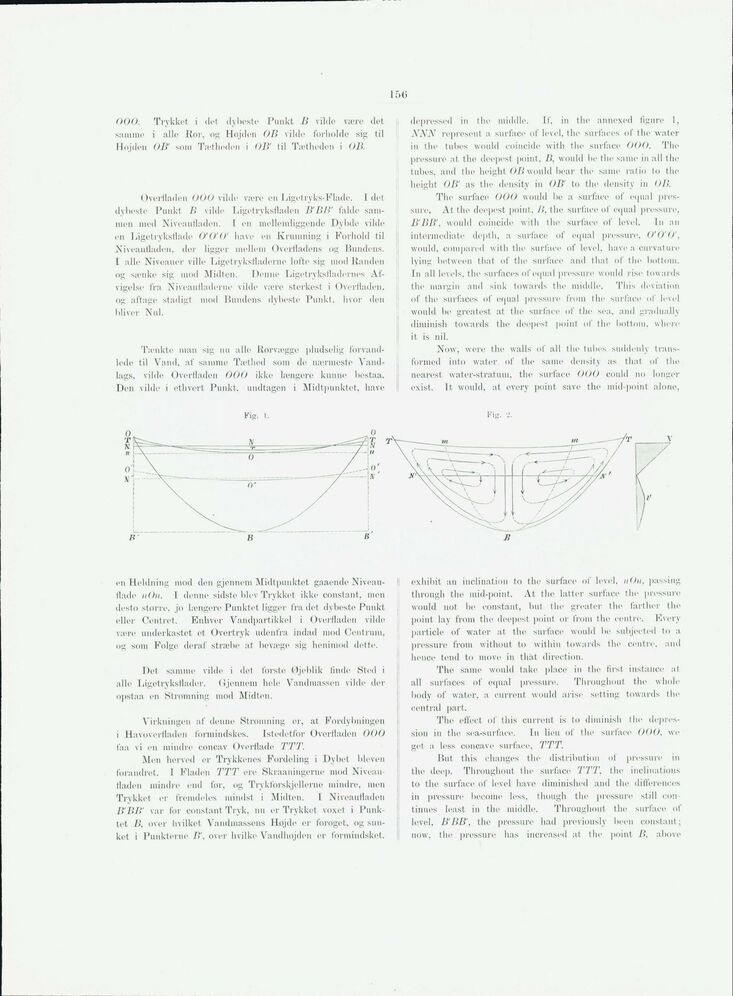
Full resolution (JPEG) - On this page / på denna sida - Sidor ...

<< prev. page << föreg. sida << >> nästa sida >> next page >>
Below is the raw OCR text
from the above scanned image.
Do you see an error? Proofread the page now!
Här nedan syns maskintolkade texten från faksimilbilden ovan.
Ser du något fel? Korrekturläs sidan nu!
This page has never been proofread. / Denna sida har aldrig korrekturlästs.
loi»
000. Trykket i det dybeste Punkt B vilde være det
samme i alle Ror, og Højden OB vilde forholde sig til
Hojden OB’ som Tætheden i OB’ til Tætheden i OB.
Overfladen OOO vilde være en Liget ryks-Flade. I det
dybeste Punkt B vilde Ligotryksfladen B’BH’ falde
sammen med NiveauHaden. 1 en mellemliggende Dybde vilde
en LigetryksHade O’O’O’ have en Krumning i Forhold til
Niveaufladen, der ligger mellem Overfladens og Hundens.
I alle Niveauer ville Ligetrykstiaderne løfte sig mod Randen
og sam lu; sig mod Midten. Denne Ligetryksfladernes
Afvigelse fra Niveautladerne vilde være sterkest i Overfladen,
og aftage stadigt mod Bundens dybeste Punkt, hvor den
bliver Nul.
Tænkte man sig nu alle Rørvægge pludselig
forvandlede til Vand, af saiume Tæthed som de nærmeste
Vandlags. vilde Overfladen OOO ikke længere kunne bestaa.
Den vilde i ethvert Punkt, undtagen i Midtpunktet, have
depressed in the middle. If, in the annexed figure 1,
NNN represent a surface of level, the surfaces of the water
in the tubes would coincide with the surface OOO. The
pressure at the deepest point, B, would be the same in all the
tubes, and the height OB would bear tin» same ratio to the
height OB’ as the density in OB’ to the density in OB.
The surface OOO would be a surface of equal
pressure. At the deepest point, />’, the surface ol’ equal pressure,
B’BB’. would coincide with the surface of level. In an
intermediate depth, a surface of equal pressure, O’O’O’,
would, compared with the surface of level, have a curvature
lying between that of the surface and that of the bottom.
In all levels, the surfaces of equal pressure would rise towards
the margin and sink towards the middle. This deviation
of the surfaces of equal pressure from the surface ol’ level
would be greatest at the surface ol’ the sea, and gradually
diminish towards the deepest point ol’ the bottom, where
it is nil.
Now, were the walls ol’ all the tubes suddenly
transformed into water of the same density as that of the
nearest water-stratum, the surface OOO could no longer
exist. It would, at every point save the mid-point alone,
en Heldning mod den gjennem Midtpunktet gaaende
Niveau-Hade nOn. I denne sidste blev Trykket ikke constant, men
desto større, jo længere Punktet ligger fra det dybeste Punkt
eller Centret. Enhver Vandpartikkel i Overfladen vilde
være underkastet et Overtryk udenfra indad mod Centrum,
og som Følge deraf stræbe at bevæge sig henimod dette.
Det samme vilde i det förste Øjeblik finde Sted i
alle Ligetryksflader. Gjennem hele Vandmassen vilde der
opstaa en Strømning mod Midten.
Virkningen af denne Strømning er, at Fordybningen
i Havoverfladen formindskes. Istedetfor Overfiaden OOO
t’aa vi en mindre concav Overflade TTT.
Men herved er Trykkenes Fordeling i Dybet bleven
forandret. I Fladen TTT ere Skraaningerne mod
NiveauHaden mindre end før, og Trykforskjcllerne mindre, men
Trykket er fremdeles mindst i Midten. [ NiveauHaden
B’Bli’ var for constant Tryk, nu er Trykket voxet i
Punktet B, over hvilket Vandmassens Højde er forøget, og
sunket i Punkterne B’. over hvilke Vandhøjden er formindsket.
exhibit an inclination to the surface ol’ level, nOn, passing
through the mid-point. At the latter surface the pressure
would not be constant, but the greater the farther the
point lay from the deepest point or from the centre. Every
particle of water at the surface would be subjected to a
pressure from without to within towards the centre, and
hence tend to move in that direction.
The same would take place in the first instance at.
all surfaces of equal pressure. Throughout the whole
body of water, a current would arise setting towards the
central part.
The effect ol’ this current is to diminish the
depression in the sea-surface. In lieu of the surface OOO. we
get a. less concave surface, TTT.
But this changes the distribution of pressure in
the deep. Throughout the surface TTT. the inclinations
to the surface of level have diminished and the differences
in pressure become less, though the pressure still
continues least in the middle. Throughout the surface of
level, B’BB’, the pressure had previously been constant;
now, the pressure has increased at the point B. above
<< prev. page << föreg. sida << >> nästa sida >> next page >>